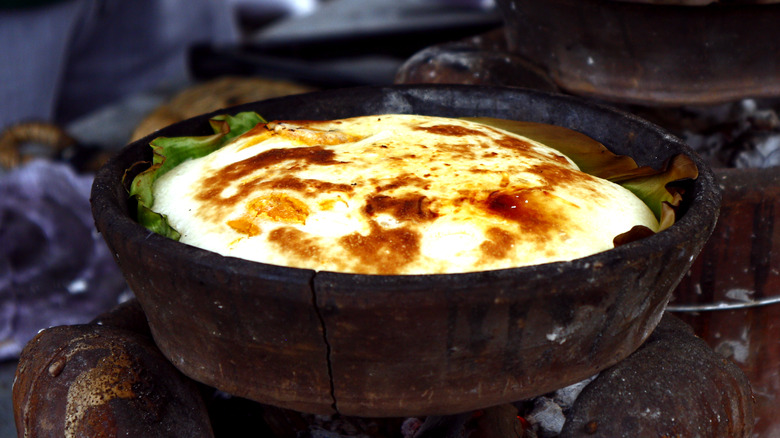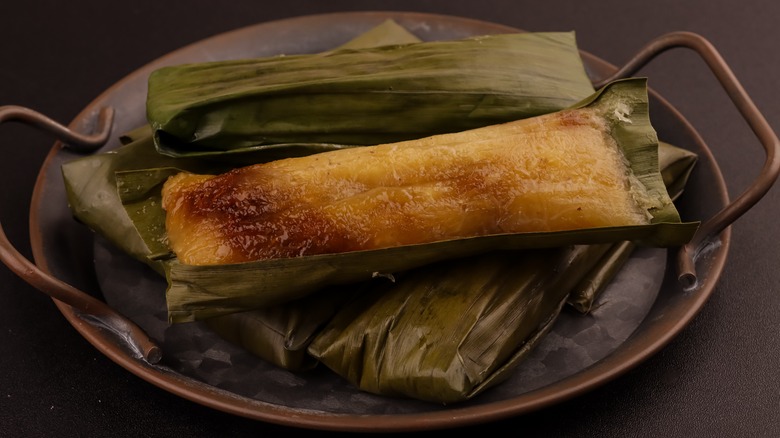Kakanin: The Rich History Of The Popular Filipino Rice Snacks, Explained
If you've never had kakanin (Filipino rice cake) before, biting into one might be a surprising experience. A sapin-sapin slice, for example, with its layers of purple, yellow, and white, might have you expecting something moist yet light, like a lemon bar. The caramel-brown biko and its sticky glaze could have you anticipating something fudge-like, whereas the pastel-colored puto looks as light as chiffon cake. What you'll get, instead, is a chewy consistency with a mild sweetness that's a delicious backdrop to different garnishes: Coconut caramel, grated cheese, toasted coconut flakes, toasted coconut milk curds, or salted egg slices.
There are as many as 15 kinds of kakanin, with some Philippine provinces having their own versions for certain rice cake types. Generally, though, they share two main ingredients: sticky rice and coconut milk, both of which are heavy players in Filipino cuisine. Glutinous rice is what's responsible for kakanin's unique texture. In fact, the Filipino word for rice, kanin, is one of the root words of its name; the other one is kain, which means to eat. Some types are made with grated cassava rather than sticky rice but they also have a gummy texture. Meanwhile, the delicate taste comes courtesy of coconut milk.
Some people treat kakanin as dessert because of its flavor. However, given how filling it is, most locals eat it as a mid-day or after-work snack. The cigar-shaped suman, specifically, is also eaten for breakfast in the southern Philippines, served with hot coffee or chocolate.
Kakanin has other Asian influences
Kakanin has been around since the 9th century. Most of its variants are believed to have been influenced by the Chinese, based on their names. Kutsinta, for example, is derived from kueh tsin tao (Hokkien for bite-sized snack or dessert), which Chinese traders introduced to the pre-colonial Philippines. Kutsinta is a steamed rice cake that's colored reddish-brown with achuete powder and with a firm yet jelly-like texture. Meanwhile, biko is believed to have Chinese roots since the first syllable in its name is Hokkien for uncooked rice.
Other Asian connections can also be gleaned from the names of different kinds of kakanin. While the same etymological principle behind biko can be applied to bibingka, the rice cake that's cooked in a terra cotta pot lined with banana leaves and surrounded by hot coals before being divided into pieces, its name is also similar to the Goan layered delicacy bebinca. Although the latter is made with eggs and flour, it also uses coconut milk and is cooked with heat from the top and the bottom, just like the Filipino version. Puto, which is a steamed rice cake, often gets amused reactions from people who speak Spanish, for its profane meaning. However, the origin of its name is the Malay and Indian word puttu, which means portioned. It usually comes either bite-sized or cupcake-sized, although some vendors cook batches in big round pans, which they then portion into smaller, trapezoidal pieces for individual selling.
Kakanin is integral to Philippine cultural fabric
Another unique aspect of kakanin is how some types are cooked and served wrapped in palm or banana leaves — materials that the Philippines is also rich in. Per F&B Report, historian Antonio Pigafetta noted this distinctive presentation in his journals during the 16th century. He witnessed how the king of the Palawan province would offer Spanish visitors banana leaf-wrapped treats "resembling sugar loaves, while others were made in the manner of tarts with eggs and honey." His observation is also proof of how kakanin has long played a significant role in gatherings. Biko, especially, is a mainstay at Filipino celebrations since its gooey, sticky texture symbolizes strong personal bonds.
Kakanin plays a valuable role, too, in some indigenous communities' spirituality. According to Filipina food historian Felice Prudente Sta. Maria (via Atlas Obscura), it's an ancient Filipino belief that there's a soul in every grain. That belief evolved into a tradition of offering rice cakes to ancestors so that the living get blessed with good health and prosperity.
There are also specific rice cakes that are popular on certain occasions. Come Christmas season, sidewalk vendors steam pirurutong (native purple glutinous rice) inside bamboo tubes to make puto bumbong rice cake delicacies, topped with butter, muscovado sugar, and shredded coconut meat. They start cooking at dawn so the rice cakes are ready by the time morning mass-goers leave church looking for a warm treat that they can enjoy together.


